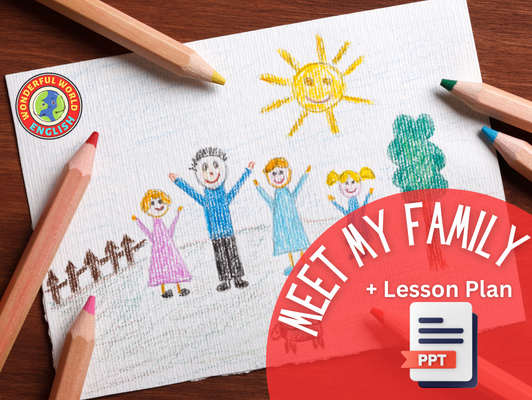


Meet David De’ Ath, co-founder, editor, and writer at Wonderful World English. With his extensive background as an English teacher, David provides valuable insights and practical tips on ESL for students and teachers alike.
If you’re an English as a Second Language (ESL) teacher or a teacher of young learners looking for some tips and materials on teaching the subject of families and family trees, you’re in the right place!
This lesson is an important aspect of English language learning, especially for young learners, as it helps them build comprehension of everyday family words.
From basic words like “me,” “mom,” and “dad” to terms like “family tree” and “baby cousin,” this lesson is a must for any young learner in an ESL curriculum.
Teachers should include materials and visual prompts to teach a lesson on families and family trees effectively. The goal is for students to understand and produce the vocabulary and be able to answer the question, “Who’s this?”. Teachers can use TPR well and keep the lesson fun and engaging.
I am an experienced ESL teacher who has taught this lesson to families many times; it is good fun and great to have in a student’s English toolkit.
I have provided the materials I use for this lesson, along with the PPT and lesson plan for you below, for free!
Feel free to use these materials in your classroom; you can add or take away anything to your class however you see fit.

This lesson is a staple in any English curriculum.
Learners need to understand the vocabulary associated with family members at a basic level before moving on to more complicated areas.
Students typically love to get involved and discuss their parents or siblings, so this lesson can be a lot of fun.
With the right mix of games and activities, songs, and movies, this will surely be a success.
Below, we will look at the lesson plan on the subject of families for a 45-minute class for young ESL learners, as well as some materials and games to include.
Here is the lesson plan:
This lesson is focused on the key sentence: “How does it taste?”, and teaches students to reply with “It’s sour,” “It’s spicy,” “It’s sweet,” or “It’s salty.”
This lesson is for very basic-level English learners, so I don’t overwhelm them.
If you believe your students can handle a little more, then go ahead and include more vocabulary, such as “it’s bitter” or “it’s delicious,” for example.
This plan should be used as a guide to accompany the PPT supplied below:

Objective: To teach ESL students family-related vocabulary, foster comprehension, and enable them to talk about their family in English.
You will need An interactive whiteboard for the PPT, a whiteboard/blackboard to keep score of points, paper, pencils, and flashcards of family vocabulary (optional).
If you’re looking for some great ideas for games and activities that you can include within your lesson plan for this lesson or any other, the guide below is for you!

Below is the PPT I made for you to use in your class; you can download this and use it as it is with the lesson plan above, or you can edit it however you would like:

“Meet My Family” is a delightful theme that allows students to delve into family vocabulary and relationships, which are integral parts of everyday life.
This lesson opens a window for students to talk about their families, promoting a personal connection to the English language.
Utilize this guide’s lesson plan and PPT as a springboard if you’re seeking inspiration for your teaching journey.
Feel free to personalize the PPT by adding or removing slides to seamlessly align with your lesson objectives.
Incorporating enjoyable games, activities, and materials will undoubtedly make your lesson engaging and memorable.
If this material aids your teaching venture, we’d be thrilled if you could share this post and follow us on the platforms mentioned below.
Your support propels us forward!
Cheers to impactful teaching and the joy of learning.
Have a wonderful day!
Image Attribution: All images licensed via canva.com